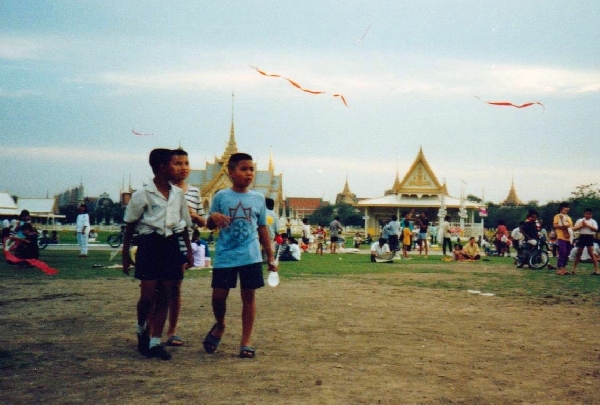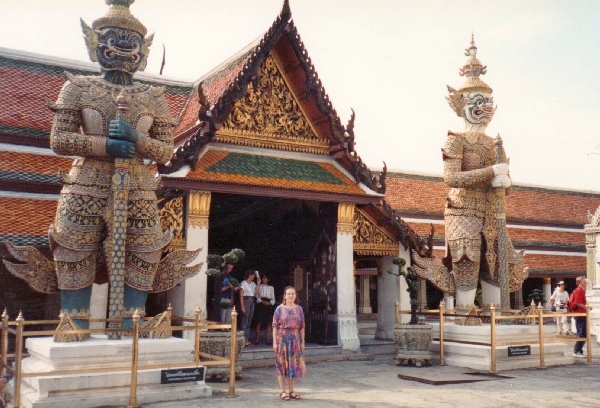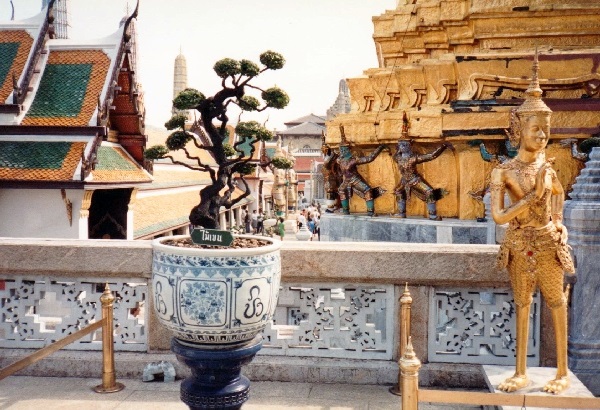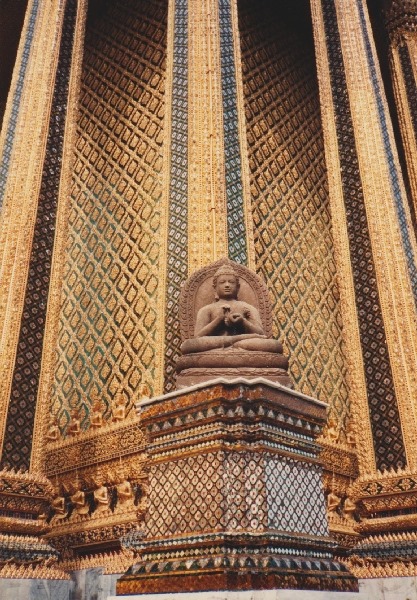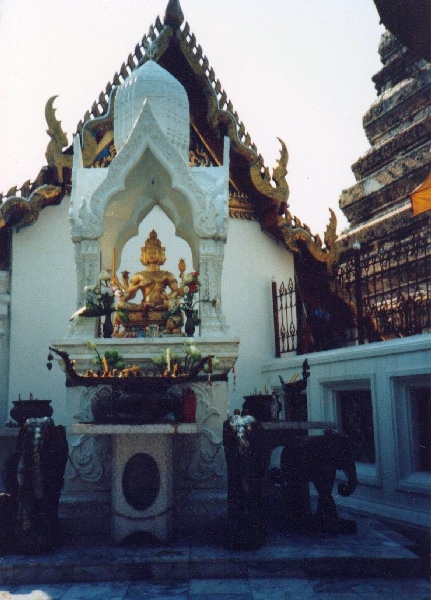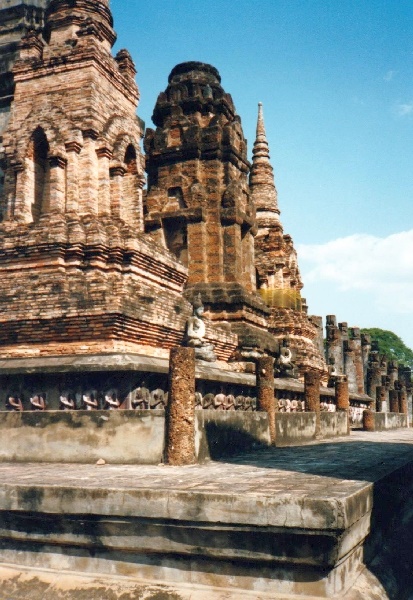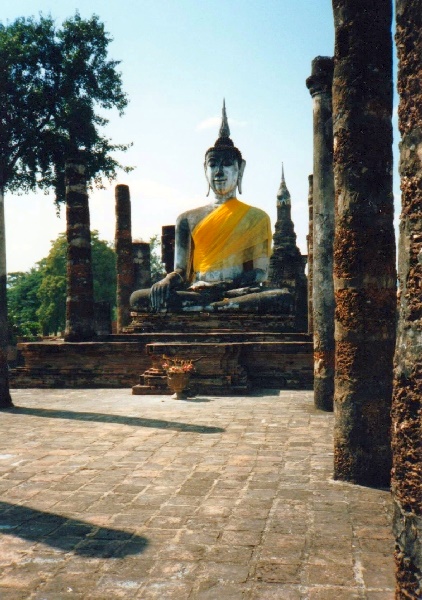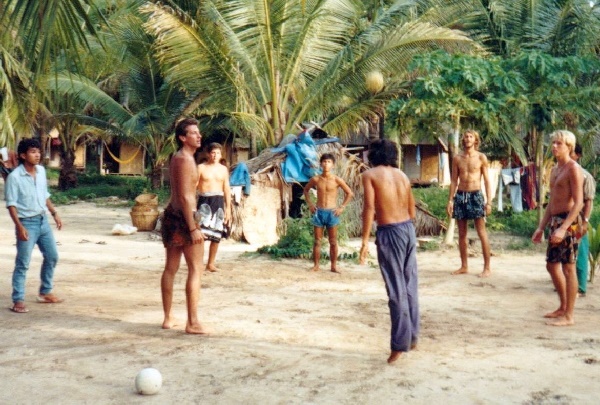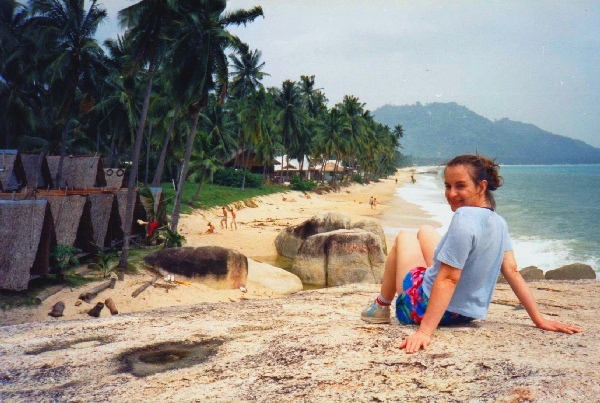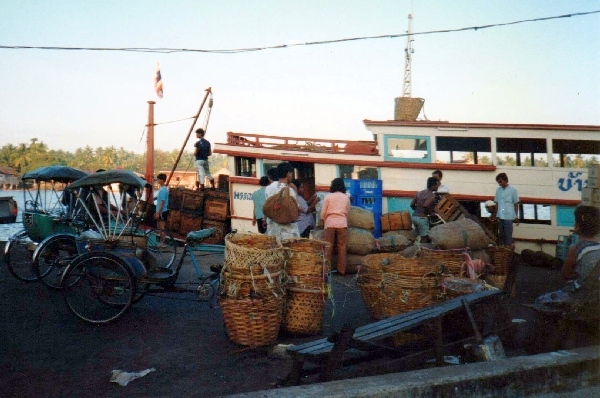World traveler Clown Tom Bolton
Adventure stories & photos

Tom’s adventure travels to Thailand
Bangkok capital of Thailand
I made trips to Thailand in 1988 and 1989, both times flying in and out of the capital Bangkok. It’s huge, hot, and humid and has possibly the worse traffic in the world. As one sees in this first photo, there are many clusters of small stands selling food or goods on the sidewalks like islands in a flowing stream of cars. Every attempt to cross a street was a life death-defying feat.
One sees a few of the tuk-tuks here, motorized 3-wheels taxis, which were generally the best way to get anywhere you couldn’t walk to. Not only cheaper than a normal taxi, they could sometimes weave in and out to reach places even faster. An elevated train system was just in the planning stages back then but if ever a city needed one – it was Bangkok. A subway system isn’t possible since Bangkok has many canals and the heavy seasonal rains would flood it with water. Bangkok is also known for its street food and many markets. The main offerings veggies and seafood, prepared dishes with rice or the icon noodle dish Pad Thai. Also available, fried scorpions and waterbugs and cockroaches.
Bangkok attractions; The Grand Palace, temples, museums
Bangkok also has a multitude of things to do and see: museums, temples, Thai-boxing rings, and all kinds of souvenirs, silk clothing, great restaurants and a famous red light district. When I was there a relatively new area in and around Khao San road had become the main backpackers’ hangout. Everything a traveler could want was available there and it was walking distance to the large Lumpini Park shown here. The park is a city landmark and was a popular place for locals to picnic, play or buy and fly kites. One often saw the remains of kites in trees and in the telephone wires throughout the country. Just behind this park is the huge Grand Palace complex that one sees better in the second image.
Grand Palace interior
Within the Grand Palace complex are also monuments, a temple and a museum. As one sees in the photo, I had on long pants and a t-shirt. Due to the heat and humidity, I usually wore shorts and a sleeveless t-shirt like the locals but had to go back to my hotel and change so I could get in.

Bangkok Buddhist Temples
I’m no longer sure at which Bangkok temples I took these photos having visited at least 6 or 7 out of dozens of notable ones there. Whether one is interested in culture, religion, architecture or art, the temples are the things to see. Even the archaeological sites are basically temple complexes.
Thailand monks’ tourists encounter
At some Bangkok temples, young monks would hang around to practice their English with the tourists. All Thai men are supposed to spend some time as a monk, so I asked what would happen if one didn’t. The answer was that a father would not consent to having his daughter marry a guy who had not thus proven his humility. Life is an unrepayable gift from our parents and to symbolize one’s respect and gratitude, one did a stint as a monk. If you couldn’t fulfil this gesture towards your parents then you would undoubtedly be unfit as a son-in-law. One young monk paradoxically told me that the non-material, contemplative life of a monk was good because it would bring focus to ones future career where one could amass lots of material wealth. So enlightenment could pay off big time! At one particular temple I was there with my girlfriend Do and friend Steve and we all got into discussions with the monks. They were also cleaning the temple which had a very different style than most of the others we had seen.
Juggling performance at Bangkok nursery school
While juggling in Lumpini Park, I was invited to eat and chat with a Thai family. It turned out that the father was a politician in the opposition who had recently gotten out of prison. He was officially sentenced for insulting the king, which is a serious offence, but the short of it was that he had been a political prisoner. This was my first clue as to the level of disorder in Thai politics, which has seen a couple of coups since. His wife ran a private nursery school and they invited me to visit them there and I made a little show.
Thais can’t read maps
The son, who had gone to University in the west, picked me up in their car. I had asked him to show me where we were going on my Bangkok map and noticed something I would later reconfirm; the sense of a city map and what it represented was simply foreign to a Thai. You can point out where they live and the landmarks on a map yet they still won’t be able to tell north from south. Realizing this saved a lot of annoyance as I would have people point out the direction and give a description rather than have them show me on a map – which would lead nowhere.
Bangkok’s sex industry
As naive as it may seem, I hadn’t heard of Thailand’s reputation for sex-tourism before I went and I wouldn’t want to exploit impoverished women this way anyway. The truth is that if I was interested in drugs and prostitutes, I could find plenty in Europe, so why should they interest me there? Yet I have nothing against nudity or erotica and I finally decided I would go to see what the red light district Pat Phong was all about. I went with an American and 2 Germans who had just come from the Philippines where they had spent a year working for a project that saved girls out of prostitution. The first place we went had a lot of beautiful young girls who really came on to us and yes they did look tempting. On the stage there was not only full nudity but also live sex shows.
The next place we went the girls pretty much ignored us. I found out that usually the girls pick the men they want and not the other way around and maybe it was clear that were not rich prospects. Not later than 1 am we were told that the bars there had to close. We were shown to another place that supposedly paid off the police to stay open later but they locked the doors behind us.
One of the girls dancing naked on the stage came and took me up on the stage to dance with her. Despite their work, nudity is strongly taboo in Thailand. I guess she thought she would embarrass me and I would run away but no, I let her undress me and danced on stage. Okay, I had drunk a few beers but so had my companions who couldn’t believe their eyes. But making a fool of myself in public is basically what I do for a living – so why not.
Prostitution in Thailand not just for foreigners
I had assumed that most of the prostitution in Thailand was connected to tourism. Yet later, in Chang Mai, I would learn that it is also prevalent with local clients. I discussed the subject of prostitution with the owners of my guesthouse there. These fairly well off people said that they saw no problem with it; the family can send off a daughter for some years and she can earn enough to build them a house. I don’t know anyone in the west who would wish this on his or her children even without the risk of disease, violence etc.
But at least a Thai girl who made such a sacrifice for her family would still have unspoken respect rather than be seen as some kind of evil outcast like in many societies. I support progressive attitudes that prostitution should be decriminalized yet am sickened by the men who use this to rationalize their taking advantage of women who are virtual sex-slaves due to poverty if not outright violence and coercion. In recent years, I have heard of some high profile cases against people misusing minors in Thailand but am rather doubtful that there is really much enforcement.
Sukothai archeological site
From Bangkok I headed north towards Chiang Mai, stopping along the way to see the extensive ruins of the old city of Sukothai. It had been the capital of the first Thai kingdom, having gained independence from the Khmer Empire. Ayuthathai (and eventually Bangkok) displaced Sukothai as the seat of power but as both ruins should be fairly similar, I only elected to visit Sukothai. The ruins are nearly 800 years old and have been designated as a UNESCO World Heritage Site.
Posing with the Buddha
Here I posed at the feet of the biggest Buddha figure, no disrespect intended although I was told later that one shouldn’t do this. Some locals had been climbing all over the figure so I assumed it was okay. It took some time to find out some of the many taboos of behavior according to the Thais. But above all, show respect for the Buddha and the king or anything that represents or symbolizes them.
Archeological sites looted for collectors
Although there were many regional conflicts, the Thais are rather proud to be the only country around that resisted colonization by western powers. Unfortunately, this didn’t stop the plundering of many of their cultural treasures. Seems the easiest way to make off with many figures was to chop them off at the feet, like one sees in this photo. One thinks of the many Buddha busts in western museums and has to consider that they were probably decapitated rather than sculpted that way. Yet plundered artifacts are as likely now to be in the hands of private Asian collectors as Western ones.
Chiang Mai, northern Thailand
I stopped in Chiang Mai, which is the biggest city in the north of Thailand yet such pedal powered rickshaw taxis, which would have been impractical amongst all of the motorized traffic of Bangkok, were very common in Chiang Mai and the rest of the country. The markets of Chiang Mai are one of the best places to find souvenirs. In addition to cloths, wood carvings and masks, Buddhist and Hindu figures in metal and stone, a major offering was counterfeit goods: pirated cassettes and CDs, fake Rolexes and identification cards, even fake American silver dollar coins. Food markets and temples were prevalent like everywhere in Thailand.
Prisons in Thailand
One wondered what was tolerated in Thailand and what not since it had become a tourist attraction to visit the westerners there in prison. In Chiang Mai I took a book as a gift although I was skeptical that one anyone caught for trafficking drugs, which seemed to be the major offence, deserved much pity. I talked to a few prisoners that claimed they were innocent; drugs had been planted on one by police in an extortion attempt. Another told me he was the victim of a scam, having bought travelers checks, which turned out to be forged when he tried to cash them. I can’t say if these people were really innocent but the conditions in the prison in Thailand didn’t look good yet better than in nearby Malaysia and Indonesia where they hang drug offenders.
Thailand’s silk industry
The silk industry is important in Thailand and the rougher weaves are more appealing to me than the shiny sort produced in China which I always think look like polyester. From Chiang Mai, I went on a tour. Here are the worms and cocoons. The cocoons are boiled and the resulting fibers, which are too fine alone, are hand reeled together to make a stronger silk thread. I had bought some silk sofa pillow cases as presents but having seen how these caterpillars get boiled alive, decided not to buy any silk objects for myself. Bleached and then dyed, the silk is then woven. Characteristic for Thai silk is the method of weaving so that it shows two distinct colors depending on the angle of light. Rather than dyed and woven, things like wall hangings or parasols are painted by hand.
Border to Burma
This is the far north of Thailand at the border to Burma by Mae Sai. A year or so later Burma changed its name to Myanmar. From Chiang Mai I had gone to Chiang Rai. Nothing of major importance in Chiang Rai but it is the biggest city to the far north and an important regional transportation hub. Despite the political unrest in Burma, there were a lot of people walking across the border in both directions but we were warned that westerners weren’t allowed across. Of course I thought it could be a good laugh to try to sneak into Burma but I didn’t think the prospect of a Burmese prison, which are said to be even worse than in Thailand, sounded so funny. There were many refugees from the tribes in Burma that hung around the border, hoping to get donations by posing for tourists. There had been some major fighting by the Karen tribe at that time which was soon afterwards crushed by the Burmese military.
Mekong River, Golden Triangle
I took these photos at the Mekong River where Thailand, Burma and Laos come together forming the famous “Golden Triangle“. The Mekong there is very wide and an important transportation artery as well as a source of fish – monster catfish are supposed to be the biggest in the world and the tales told about them challenged ones beliefs. Nearby, I saw this boy herding his water buffalos which were much more common throughout the country than cattle. One sees that the north is typically not nearly as green and wet as the south.
Northern Thailand hill tribe tours
In these photos, I was making shows while on my first trekking tour of the hill tribes in northern Thailand, which I did on both trips. The kids loved to see and learn juggling and here I used fruits, stones or simply clumps of dirt! I didn’t want them to think they needed special props to learn the basics. Visiting the hill tribes, who are culturally and linguistically different from the Thais, has become a big industry. One has to have mixed feelings to observe them almost like objects in a zoo, if they don’t benefit from the visits, then it is just intrusion, yet even if they do benefit, it must spur changes in their culture. And if they adapt many outside influences, they become like everyone else and are no longer anything special to see. I had to wonder how the people in the American Appalachian mountains would feel if thousands of foreigners would trek through their land taking pictures of the strange primitive inhabitants.
Second hill tribe tour
On my second trip to Thailand, I ran into my friend Steve in Khao San road in Bangkok. Maybe 10 minutes later we ran into Yacine, a juggler from Amsterdam we both knew. We ended up going north together and once again went on a hill tribe trek. The following shots are from the second tour. Here are Yacine and Steve on a walkway leading up to a waterfall on our trek as well as me fording a stream.
Performing & playing with hill tribe people
Other than Thai boxing, this volleyball like game seemed to be the national sport. A wicker ball is propelled over a net (or just a string in this case) using the feet, knees or head. What isn’t allowed is to use the hands or arms. At the beach, tourists were often welcomed to play with the locals in the early evenings. I like to think that we were welcome guests as we happily interacted with the locals. And we also did a group show that captured this audience, Steve adding a lot of acrobatics and sleight of hand, which I don’t do myself.
Hill tribe culture
A typical tour was one guide with maybe 5 or 6 tourists. We slept in such a local home and someone cooked some food after a long days walk. One time they roasted a rat and chopped it up. I said I was too tired to eat since I didn’t want to insult them by refusing what was said to be a local delicacy. Some locals defecated right off the edge of their houses, which were elevated on stilts and their pigs and or water-buffalo came squealing to eat the shit. And to think they would eat animals that had eaten their own waste! I had to take a dump and went off into the woods but the pigs all followed me and were all grunting around waiting for me to finish. If I hadn’t already given up eating meat, these were the kind of incidents that would have inspired me. Despite such primitive conditions I saw at least one school in such a village. No idea what level of education they might have been getting but at least there was some sort of effort.
Smoking opium
Another big attraction of the hill tribe treks was to smoke opium with the locals. I only watched the first time around and on my second trip went ahead and tried it. I felt a feeling of relaxation and bliss just wash over my tired body. No hallucinations but also no pain or hunger which must be a great attraction to the locals after a hard day of labor. One can easily see how it would become addictive even if one weren’t chemically dependent. I once met a western doctor who was in the juggling scene who went to Asia for the opiates. He thought he was too smart to get hooked but I later learned it turned out otherwise.
Husking rice tribal style
Here are two views of how they pounded the grains of rice to remove the husks. One used a stepping action with a foot to move a log on a lever. And to think how Americans spend time on a step-master just to work up a sweat, the ultimate Thai hill tribe version would be a double-footed grain pounder!
Elephants through the jungle
There is a tradition of the hill tribe people catching and training wild elephants, usually with cruel methods. Part of our tour was on elephant through wet, slippery and hilly terrain. Once one of the elephants slipped to his knees and I could only imagine his taking a full tumble and rolling over someone. I later learned that it is particularly distressing for elephants to go down such steep inclines at all, none-the-less with people on top of them. My head was a bit fuzzy which I think was a hangover effect from the opium the night before and I got motion sickness from the gait of the elephant as he labored on uneven ground. Then we had a break and were offered green, unripe mango and I retched my guts out soon afterwards.
Phang Nga Bay, Railay Beach
Southern Thailand has great beaches both on the mainland and on its many islands. One of my favorites on the west coast was Railay Beach on Phang Nga Peninsula (there seems to be some alternative spellings like Phra Nang) near the town of Krabi. It was so hot that I would wait until close to sunset before training. Typically, a spectator would want to learn to juggle. When others saw that it could be learned in one lesson, they would want to try as well. A week at the beach and I would have 30 or more people all coming to train. This was back before the big raves and when juggling wasn’t so popular so it was a special experience.
Railay Beach was a hedonist lifestyle. Just hanging at the beach, meeting people playing volleyball and a similar game that uses the feet as well and often with a wicker ball. Many real travelers were there in those day. I’m pictured with a friend I made from Munich who I also a month or so later bumped into in Bali. I meet people who bought jewelry in Asia and then sold it in Europe or the Americas – and sold some of their wares right on the beach. It was kind of a constant party although not on the level such places would become known for their crazy raves. As the one picture indicates, some were into the consumption of magic mushrooms and creating art work.
First time to Thailand I just enjoyed it. Second time, a year later, I started to look behind the smiling faces and recognize the distress the locals often felt by tourists breaking their taboos. This was often unintended and simply a lack of cultural knowledge rather than mere insensitivity. But at many beaches, the tourists tended to feel that they could do whatever they wanted since all of the local facilities were for them. Not only nudity or women going topless but even cuddling in public especially in the water were a cultural taboo. The flood of tourism that has washed over Thailand has brought in money but probably impacted their traditions as profoundly as the Tsunami, which later washed over this beach.
On the other hand, some of the young Thai workers seemed to really enjoy hanging out with the tourists. I had been at Railay Beach and left for some days. Returning there were simply no bungalows available. I spent one night sleeping on the beach with just my sarong over me and got a bit of a cold. One of the locals who had been coming to my juggling group gave me what turned out to be his own room for a couple of days. Little did I know that he ended up sleeping on a table in the restaurant there.

Princess Cave
The Phang Nga Bay area is full of cliffs and is great for climbing. In the cliff at one end of Railay Beach was a cave known to westerners as Princess Cave where the locals put many phallic symbols. It is not an extensive cave but does have some nice stalactites. They would often take small offerings of incense, flowers or food for the animist spirits of fertility. Every house would also have a shrine to whichever spirits. I’ve never figured out how such beliefs and rituals fit together with Buddhism but they seem to be mutually significant to the Thais.
Thai caves – Bird nest soup
In this area were many caves where a particular type of swiftlet lives. They make nests out of their hardened saliva that when boiled become like a natural noodle. Bird nest soup is supposed to be a delicacy that brings a particularly high price in China. A whole industry has evolved out of people harvesting the bird nests from such caves. They reach the nests by climbing up bamboo poles that are left in place in some locations. It looked like a death defying job. The people making the safer money are the ones who arranged boat tours for tourists to visit such caves. The panorma photo blow was taken on the bird nest tour when we stopped at a local harbor.
Beaches & climbing cliffs at Phang Nga
This is an overview of Phang Nga peninsula, which is only accessible by boat due to the steep cliffs. From the beach seen here – East Railay, it is just a couple hundred meters west to the more developed beach side known as AO Nang shown on the 2 previous photos. This small flat area was being developed quickly while I was there. Bungalows were flying up while others were being torn down to build more deluxe ones or to make room for the next resort. There was hardly enough water in the wells here to wash off at the end of the day so I don’t know they were going to cope with adding swimming pools and such. The eastern side here was shallow and muddy so not attractive for swimming but there was lots of crabs and often luminous plankton.
Close to the viewpoint above was a trail to a nearly sheer cliff, which had some pieces of rope and bamboo attached in addition to tree branches, which one could use to scale to the top. The following photo is of the foliage on the trail down the other side into the water filled crater of an old, small volcano. No technical climbing skill was required but one needed upper-body strength and stamina and the probability of death or serious injury if one fell made it an adrenalin rush.
Low tide at Phang Nga Bay
While staying by Railay Beach there was an extremely low tide one day. There was a lot of coral and sea-life like sea urchins and sea cucumbers nearly out of the water. I remember walking out at least one or two hundred meters to check things out. This memory really struck me later when the tsunami did so much damage to such places. I wasn’t really aware of the cycle of the moon and such an occurrence would have been similar to the water receding before the tsunami. It never occurred to me at the time that this might have been a sign of danger. My concern at the time was to avoid stepping on the sea urchins. Their spines tend to break off and stay in your foot which is a rather painful experience.
East coast islands – Koh Samet & Koh Samui
This picture shows squid drying on a beach on Koh Samui, which was one of my favorite islands. I had gone to Koh Samet (also off of the east coast) , which is one of the closest islands to Bangkok, but it was already way over-developed. Phuket had already gone upscale and Pattaya was firmly established as the sex-tourism capital of Asia so I avoided those two. The big destination of choice was then Koh Samui, which was changing quickly but the airport wasn’t built yet.
Due to Koh Samui’s rapid development, backpackers were already going farther to Koh Phangan and Koh Tao, close by islands off the east coast where they were still without electricity. I had intended to go to these islands on my second trip after visiting Koh Samui but the weather decided otherwise. We had nearly a week of torrential rains and heard that the west coast of Thailand was much drier at the moment so off we went. There were even some small landslides and huge boulders washed onto the road on the way to the ferry, which helped convince us it was time to leave. Although the beach looks pretty quiet in this shot, there were bungalows just beyond the palm trees. I doubt there was any beach left on this sizable island without an unbroken line of bungalows or a resort.
Temple on Koh Samui
I don’t remember what this temple was called but it was one of the few cultural things we saw on Koh Samui. Mostly one hung out at the beach and the day revolved around eating and socializing. But we went off to see another temple. It was common to see deities in addition to the classic Thai Buddha. The monster looking figures with the lower fangs are supposed to be some reincarnation of Buddha common to Indian Tantric traditions. The fierce deities are supposed to destroy obstacles to enlightenment. Yet near the temple were additional figures. I just don’t know if they come from some Thai historical mythology or possibly some Hindu gods. Hinduism tries to incorporate Buddhism into its fold. The Buddha should be an avatar of god Vishnu. Buddhists don’t accept this interpretation. Yet one sees lots of examples of Hindu and Chinese religious influences and Animistic traditions practiced by Thai Buddhists.
Thailand Beach restaurants
These were typical Thai beachside restaurants, I think the one to the left below at Railay Beach and the Spanish Eyes on Koh Samui. Noodles or rice served with veggies and some type of seafood was the standard fare, freshly cooked in a wok and always heavily spiced, we foreigners needed the toned down version. Even then, many meals burned both on the way down and the way out again, literally strong enough to blister your flesh. I love Thai food but even so had difficulty at times, finding it much hotter than anything I ever ate in Mexico or India.
I even saw Polish tourists that had brought a few weeks’ worth of bread and sausage from home because they couldn’t eat the local food. And need one mention the various roaches eaten as snacks. The two Germans in the photo to the left turned out not only to live in Tübingen where I was also living at the time but actually had a couple of American musician housemates that I knew.
Ferry transport to Thailand Islands
To get to Koh Samui, one could take a wooden ferry like pictured below. Once I took a much larger, faster ferry that held a few hundred people. The water was very rough and the captain was trying to go as fast as possible. Some of the tourists were sunning themselves outside in front and a big wave caught them and threw them through the large windshield. The most seriously injured person was just inside and got landed on by the people, water and glass. We had to leave him off at the next possible island since his head was slashed down to the skull. For short rides there wre motorized canoes and the panorma shot below shows some of the local fishing boats. One would see a train of lights at night on the horizon as they fished especially for squid.
Thailand- no safety regulations
Safety regulations were not a top priority in Thailand as one often saw families of 3 or even 4 on a motorcycle – without helmets of course. I think I read that about a dozen tourists also die in traffic accidents each year on Koh Samui alone. Typically a young guy would rent a motorbike, get drunk with his buddies and then speed on the curvy, often wet, roads. Drowning is another obvious danger which almost happened to me. The opportunity to take a midnight swim with a sexy girl seemed like a brilliant idea at the time. However, the surf had gotten a bit rough and it was hard to see when the waves were breaking. Every time I gasped for air, the next wave would hit me and I almost went under.
Typical beach bungalows in Thailand
To the left was a deluxe 8 to 10 dollar a night bungalow on Koh Samui. On the right a more basic one, bed with mosquito netting and use of a communal shower, often with one of those electric water heaters, which dangled dangerously just above your head, costed just 2 or 3 dollars. I don’t know if people have died but there was always a risk of a serious shock if you raised your arms to wash and accidentally touched the heater. Such basic accommodation was enough for most of my travels but my girlfriend was with me here and we splurged for a place with a private shower and a fan since it was sometimes too hot and humid under the mosquito nets to sleep. Another difficulty throughout Thailand was the multitude of vicious biting ants. More than once I returned to my bungalow to sleep to find a trail of thousands of ants going right over my bed.
Cobras & other snakes
One also had to check for snakes, nearly all of which in Thailand are very poisonous. I once had a cobra drop down onto our path while going through a bamboo grove in northern Thailand. On Koh Phi Phi I stepped over a snake to go use the toilet at a restaurant by the beach. Someone called my attention to it and I bent down close to get a good look. It reared back and there was no mistaking that it was a cobra. The locals completely freaked out so I helped stone it to death, which I later regretted. I had rationalized that a snake in the wild is best avoided but one that would be bold enough to show up amidst all these people at such a place was too dangerous to ignore but I would rather have seen it gotten rid of unharmed. The picture of me and the snake is hard to make out. There was someone with their pet monkey on a leash there, which is probably a worse treatment of an animal than to kill a poisonous reptile.
Koh Phi Phi Island, western Thailand
Another island I visited was Koh Phi Phi. Its south of Phang Nga Bay, more in the open sea. It had recently been a sleepy island with a small fishing village there before I arrived. Developers bought the land out from under the community and leased some space back to them. The people thought they were getting rich and could stay there as well. But they had to spend so much for the rent that they were soon destitute and the small place was overrun by tourists.
And after just a couple of years it was already full of garbage. The locals had almost exclusively used natural materials, for example a banana leaf to eat off of, which simply decomposed when it was thrown away – so there was no need for systematic garbage removal. Now there were masses of cans and plastic water bottles all over the place, the waste of providing for the tourists.
Keeping ahead of the guide book tourists
It used to be that there were always new places opening up, so to find the next cheap, laid-back scene, one just had to stay ahead of the masses following their Lonely Planets. But the number of islands is not unlimited, so I think it has changed a lot since the late 1980’s. A lot of people said how bad the Leonardo di Caprio film “The Beach” was but I found it a realistic presentation of Thailand; lots of backpackers looking for a never ending party, having conflicts with the locals who want to make a profit but without losing their self-respect and national pride. There were many tourists pretentiously wanting to find some unknown paradise but needing a guidebook to tell them how to get there.
So, those were just a few tales from my many travels over the last thirty and something years. I hope you've enjoyed another side of a traveling clown! If you want, write me an email or better yet, book my show or set a link to this website or just state me as the beneficiary of your will!
To book or see more information about Tom's clown show and entertainment, visit one or both of his clown websites:
Clown Stuttgart www.clowntombolton.com
Clown juggler Stuttgart, Gremany www.clown-event.de






